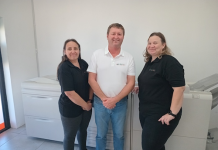According to OneVision, while digital transformations are being pushed and implemented, smart entrepreneurs should also consider digitising and optimising areas and activities of their business that correspond to more than just their own core competencies.
Does ‘digital’ mean to integrate the latest technology into every single part of a business? Or does it imply becoming completely paperless? In its essence, the concept of digital transformation is not just about using digital technologies to solve problems, rather, it is about aligning your business to be future-proof and successful.
Let us start with a specific example: the core competence of grocery retailers is to offer customers a wide range of fresh and non-perishable food products as well as everyday commodities. In order to communicate and promote the products and prices to consumers, retailers need a large amount of different printed information, such as price tags, many of which change very quickly due to new promotions. If this printing process is digitised and automated, companies can benefit from lower costs in this sector and consequently from a higher overall profitability.
In addition, think about e-commerce, currently booming amid the Covid-19 pandemic. Almost every delivery requires a printed delivery note. The package insert for medications, for example. The label that tells us where and how our clothes were produced. Of course, it also directly affects printed materials related to the pandemic – barcode-based packaging of vaccines, banners and signage explaining how a coronavirus testing centre works or governmental entities providing information and documents to government members and citizens, to name a few.
Companies operating in the industries and fields mentioned above certainly do not have ‘printing’ as a core competence. However, all of them need printed information and/or documents with information in digital form for their daily business. What is the best way to generate them? Ideally in-house through in-plant printing, because in today’s fast-paced world who has the time to outsource this step to an external service provider? In addition, there could also be confidential information involved that companies do not want to risk revealing.
Automated workflows, file preparation and production planning
Decision-making processes of government institutions constitute another sector in which a lot of documentation has to be done. In an everyday rapidly changing world, thinking of court proceedings, both external and internal documentation must be done in a very fast manner. Confidentiality of data is, of course, paramount in these environments and another indicator why outsourcing cannot or should be done only with caution.
Producing such documents quickly and confidentially is no problem for The United States Government Publishing Office (GPO), one of the largest in-house printing organisations in the US. Using inkjet and automation technologies, the GPO produces a high volume and wide variety of printed products in a very short time every day.
With in-house printing, this means recurring work steps and processes in the value chain run automatically via software. With an automated workflow, automated file preparation and automated production planning, manual operations are eliminated, error rates are lowered, costs are reduced and efficiency is increased.
But what does this mean for entrepreneurs and their organisations? It means they should be brave enough to let automation take care of the things they do not specialise in and let new profit centres emerge. These profit centres face current market changes, such as with in-house printing smaller runs in shorter times, more personalisation and they use intelligent automated solutions to accomplish them.
Automation does not just happen naturally – you need to set it on its way. Software companies that do their work properly conduct an on-site assessment, gain an overview of goals, product ranges and current production processes, propose solutions that automate production and make it more economical. This requires the co-operation of the company: the people involved must take the time, usually in addition to their day-to-day business, to determine the actual situation and the target figures, together with the software company. However, this time investment will be rewarded – you will create completely new profits within your company. The world belongs to the brave.
ONEVISION
https://www.onevision.com/





















